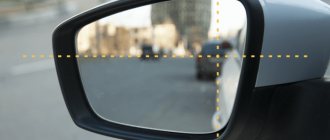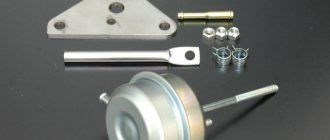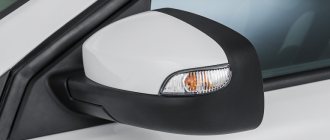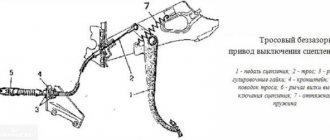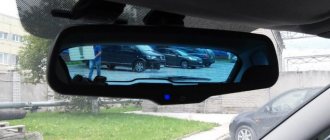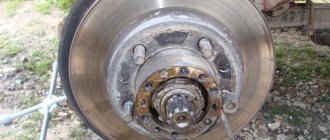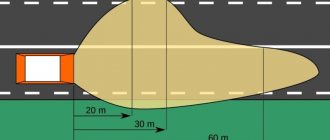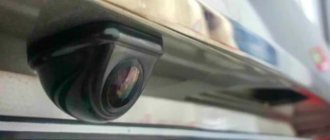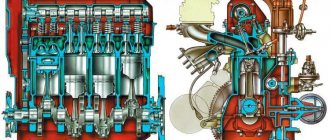A question that is relevant for many drivers, especially for beginners, is how to properly adjust the mirrors in a car for the best view. After all, this is not at all easy, and you need to know the setup technique, which we will talk about in this article.
If you look in the side mirror and see the rear wing of your car, this means that the mirror is not adjusted correctly. With this mirror arrangement, most of the area behind the car is visible both in the side mirrors and in the rearview mirror. At the same time, the area next to the car is very poorly visible and creates the risk of an emergency.
Test Drive
After driving with mirrors configured in this way, you will notice that there are much fewer “blind” spots. You see the car in the rearview mirror, and if it starts to overtake you, then you still see part of it in the rear mirror, and part of it in the side mirror. Thanks to this, it is easier for you to change lanes, and the risk of an emergency situation is significantly reduced.
Side mirrors
In terms of importance, side mirrors are even higher than the interior mirrors. Indeed, some cars do not have interior mirrors at all due to the lack of visibility through the rear window. Side mirrors, unlike the interior mirrors, mostly have a spherical rather than a flat surface. This creates a panoramic view and reduces the blind spot.
See also: How to get an international driving license?
Although some cars are produced with straight mirrors, since the spherical shape of the side mirrors distorts reality and visually distances the object in the driver’s eyes, and an incorrect assessment of the environment can lead to incorrect actions by the driver and the creation of an emergency situation. But we will look at setting up mirrors specifically for a flat mirror surface. It is important that when adjusting the exterior mirrors, the adjacent strip of road surface is visible. But in order to correctly assess the road situation, you need to have a small part of your car visible.
See also: Driving a car in winter: subtleties and features
Some useful tips:
1. At first it will be very unusual for you to drive with mirrors configured in this way. But wait a week and you will get used to it so much that you will not understand how you drove differently before.
2. Be careful when parallel parking. With this alignment of the mirrors, you need to turn your head more and lean away to see both the side of your car and the car next to it.
3. Constantly glance at the mirrors, and not just at the moment when you want to change lanes. This manner will allow you to constantly be aware of the situation on the road and correctly make sudden unexpected maneuvers (for example, when you go around a hole).
How to properly align mirrors in a car?
This information is especially relevant for those who are just learning to drive a car or have just passed their exams at a driving school, but it will also be useful for those who have been driving for quite some time. Getting the settings right the first time can be a little tricky, but knowing how to adjust your mirrors correctly is very important as it will ultimately determine what you can see around the car. In other words, the safety of the driver, his passengers and other road users.
Adjusting the mirrors
seam sealant for cars how to apply correctly
Now let's move directly to the question of how to properly adjust the mirrors in a car. The procedure for adjusting the reflective elements is as follows:
- First of all, you need to adjust the driver's seat and find a comfortable position for yourself. There is no point in adjusting the mirrors before the chair is adjusted, otherwise everything will have to be adjusted again later.
- Now that the chair is in the correct position, you need to adjust the left mirror. To do this, you need to tilt your head to your left shoulder and touch your head to the glass. In this position, the rear wing of the car should be visible in the mirror. If it is not visible, then it is necessary to adjust the mirror so that the wing appears in the visibility zone. Once you are in the correct position, in the mirror you will only be able to see the edge of the rear wing of the car. That's how it should be.
- The level of the reflective surface must be adjusted so that the horizon line of the panorama is parallel to the horizontal axis of the mirror itself or even slightly higher. That is, in the mirror the driver should see most of the road surface, and not the sky and treetops.
- To adjust the right mirror you need to do approximately the same operations. In particular, you need to tilt your head to the right and set the reflective sheet in a position where the right wing will be visible. In a comfortable position on the seat, only the outermost part of the rear fender will be visible in the right mirror - you need to be guided by it when parking the car. The horizon line should be the same as on the left mirror - slightly above the middle.
If you install the side mirrors in this way, the visibility of the situation behind the rear of the car will be optimal. The blind spot will still remain, but it will be minimal. There will be no reminder that these elements need to be adjusted only in a car that is not in motion. Some drivers, noticing that the side mirror has a blind spot, try to correct it while driving. This is very distracting and increases the risk of accidents. If the reflection is really incorrect, then the car needs to be stopped on the side of the road and the mirror adjusted. So, now you know how to properly adjust your car mirrors. A photo of what the driver should see in the reflection is attached.
Why are blind blind spots dangerous?
There are always blind spots, they are extremely dangerous and often provoke an emergency situation on the road. This concept hides the space around the car, which the driver does not see while in his seat. Blind spots are always present; it is impossible to completely remove them. Even with proper installation of reflective structures, they remain, but become less dangerous.
Blind blind spots are present on the sides, rear and front. For example, a car that is overtaking leaves the view of the interior element and appears in the side mirror only after a while. Such zones can also appear due to objects that obstruct the view (houses, trees, vehicles).
It is necessary to adjust the mirrors in the car so that there are as few dead spots as possible, and each of them carries minimal danger. Every driver should worry about this; moreover, the location of each of these elements should be periodically checked. We will now tell you how the car’s side mirrors and the interior mirrors for rear visibility should be configured. We advise you to carefully study this information and correctly apply it in practice.
The nuances of adjusting mirrors
You should be very careful when setting up mirrors. The goal of proper adjustment is to reduce the number of blind spots around the car. This is a space that is not visible when the driver is in a natural position. Control over blind spots is especially important when changing lanes in heavy traffic, rear parking and other maneuvers.
Reflectors are always installed at an angle, and the degree of visibility of objects depends on the distance to the mirror and the viewing angle.
The design of individual cars makes it extremely difficult to get rid of blind spots. But there are few such cars. Most models allow you to adjust the mirrors to the optimal degree.
These additional tips will help you set up your reflectors better.
- When reversing, you can control the car using the mirror closest to the driver, but only if you are sure that there are no obstacles on the right.
- Beginners are advised to install additional reflectors and point them at hard-to-see areas.
How to adjust the mirror inside the cabin?
You don’t need to look at the sky, so we set the interior mirror so that you can see the lower edge of the rear window.
Another sign of a correctly adjusted element is when in the reflection you can see part of the driver’s seat headrest or part of your own ear. In modern passenger cars, where seats have high backs, these are very correct guidelines.
Remember that the interior mirror should not distort the space behind you, otherwise such “tuning” will turn against you.
In modern cars, the rear window is like an embrasure, you can’t see anything through it, so your “eyes” are mainly the exterior mirrors.
What are “dead” zones
“Dead” (“blind”) spots are areas to the side and behind the vehicle that are not visible to the driver from his seat.
“Dead” zones are dangerous because the driver does not see in his mirrors a vehicle overtaking or moving in the adjacent lane. He may begin to make a maneuver that is almost guaranteed to end in an accident.
Pin
This is why correct adjustment of the rear view mirrors in a passenger car is so important. It allows you to capture as much of the roadway as possible and reduce “dead” zones around the vehicle to a minimum.
As a result, the driver has the opportunity to maximize control of the situation behind and on both sides of his car.
Adjusting the side mirrors
Such mirror structures are installed to view a certain part of the machine. Also in such mirrors there should be a reflection of the road surface and the side of the road, which remains behind the car. In addition, the field of view must include cars moving behind.
Next we will describe the rules in accordance with which the side mirrors of the car should be adjusted. We advise you to take this information very carefully and seriously:
- the custom element must reflect the side of the car; according to the rules, it can occupy no more than 2 cm of the total area of the mirror;
- the lower part of the mirror element coincides with the horizon line;
- The main area will be occupied by the roadway, which is located behind the car.
A common mistake among drivers is that the side of the car is not reflected. In this case, the connection between the situation on the road and the car will be disrupted and it will be difficult for the driver to correctly assess the situation. You know how to properly adjust the side mirrors of a car; all that remains is to figure out the elements for rear visibility.
When should you not adjust your mirrors?
Before you start adjusting the mirrors, one piece of advice: do not do it while moving. Moving the interior mirror a little is not a problem. But you will have to be thoroughly distracted by external ones, which threatens an accident.
Of course, we are all aces, and we do what we want on the go, but it’s still better not to take risks, but to pull over to the side of the road and set the mirrors for yourself.
Types of car mirrors
There are several types of car mirror elements:
- Interior structures provide visibility to vehicles moving behind. They are necessary when performing a reverse maneuver for parking.
- Side elements are necessary when changing lanes, turning and parking.
A typical passenger car has three mirror elements: two on the sides and one in the interior. In addition, structures can be installed that will provide visibility to blind spots. On larger vehicles, such additional mirrors are separate elements. In the case of passenger cars, there are inserts for the main elements. They are inaccurate and serve only to convey a general picture.
This is not the only division into species. There are also the following types of car mirrors:
- Aspherical and spherical elements increase the viewing angle, but at the same time distort the reflection.
- Flat reflective structures are very clear, but they have a small viewing angle.
How to properly look in mirrors when driving
In order for the trip to be safe and the distance between cars to be correct, you need to learn a simple technique. You can look in the left mirror without turning your head, in the right - by turning it slightly. In this case, it is advisable not to take your eyes off the road for more than 1 - 2 seconds.
Experienced drivers monitor the situation behind, on the left and on the right, not only when changing lanes or changing the trajectory. It is better to do this constantly to have an idea of what is happening around the car. With this approach, the risk of accidents will decrease.
What should you always remember?
Rely on the mirror, but don’t be bad yourself. No one has yet canceled the “blind” zones, and no matter how you adjust the mirrors, there will still be an “invisible” sector.
Therefore, before you overtake or change lanes, look around. Make this a rule. Personally, this habit has saved me more than once.
When backing up, open the left door, and don’t be too lazy to stand up to look to the right - then you definitely won’t shuffle along the curb. Although, if your car’s side mirrors lower simultaneously with the reverse gear, and you can see everything on the side of the wheels without straining, you can only be congratulated.
Photos of Internet resources
Adjusting the rear view mirror
The height and slope should ensure that the central part of the reflector is positioned virtually in line with the middle of the rear window. The instrument must completely reflect the rear glass and the edge of the driver's ear.
Some mirrors have a lever that switches it to night mode. The function is extremely useful when traveling at night, when there is a possibility of the driver being blinded by the headlights of a vehicle behind, but, in turn, this option reduces visibility. The advantages include the fact that when changing the position of the switch, the mirror setting is preserved and it is enough to return it to its original position. The mode becomes irrelevant when tinted.
